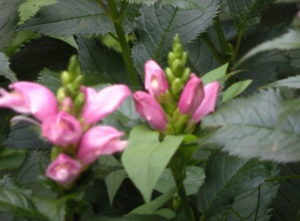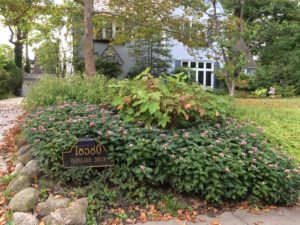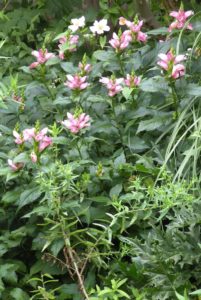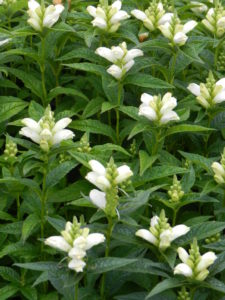
Chelone ‘Hot Lips’ closeup from my garden
One of the mainstays of the August/September perennial garden is Chelone. Its unusual flower is named after the head of a turtle but if you look at the photo, you can see that someone had a vivid imagination. Nonetheless, the way the petals are clustered is unusual. Happily, it is deer resistant and attracts hummingbirds and butterflies. A North American native that loves partial shade and moist soil, this perennial is hardy from zones 3-7.

Chelone ‘Hot Lips’, Hydrangea quercifolia, Carex ‘Ice Dance’
Chelone lyonii (Pink Turtlehead) is the best known species, mainly due to brilliant marketing of the cultivar ‘Hot Lips’. How could anyone resist that name? It’s fat, terminal spikes are a perfect lipstick color – rosy pink, a deeper pink than the species. It supposedly has red stems but I see no evidence of that. It grows two to four feet high and spreads slowly by rhizome. I say slowly because in my garden, it really hasn’t spread that much. However, in a moister situation, it probably would. The foliage is a rich, deep green. Amazingly, it has done quite well on a client’s slope that gets some water but certainly doesn’t stay moist.

Chelone ‘Hot Lips’ blooming in part shade but does not lean
I use it as a middle of the border plant in my back garden where it has been for twenty years, through every permutation of weather. At one time, I partnered it with Lobelia ‘Ruby Slippers’ and Miscanthus ‘Variegatus’ but, sadly, the Lobelia has disappeared. One of its other assets is that, unlike many perennials in part shade, the flower stalks do not lean toward the sun.
There is a new cultivar that I have yet to purchase called ‘Tiny Tortuga’, exactly the same but only fourteen to sixteen inches high. This means that it could be used at the front of the border. There is another similar species, C.obliqua (Rose Turtlehead) but I rarely see it offered and Allan Armitage says that he really doesn’t see much difference except that it is less hardy.

Chelone glabra at a Dutch nursery
Chelone glabra (White Turtlehead) blooms at the same time and in the same conditions as pink Turtlehead but is supposedly only two to three feet high. Unlike the shade preferring Chelone lyonii, this one loves full sun.
Both species look great in large groupings. For a late summer/early fall perennial, it’s hard to do better than Chelone.


0 Comments